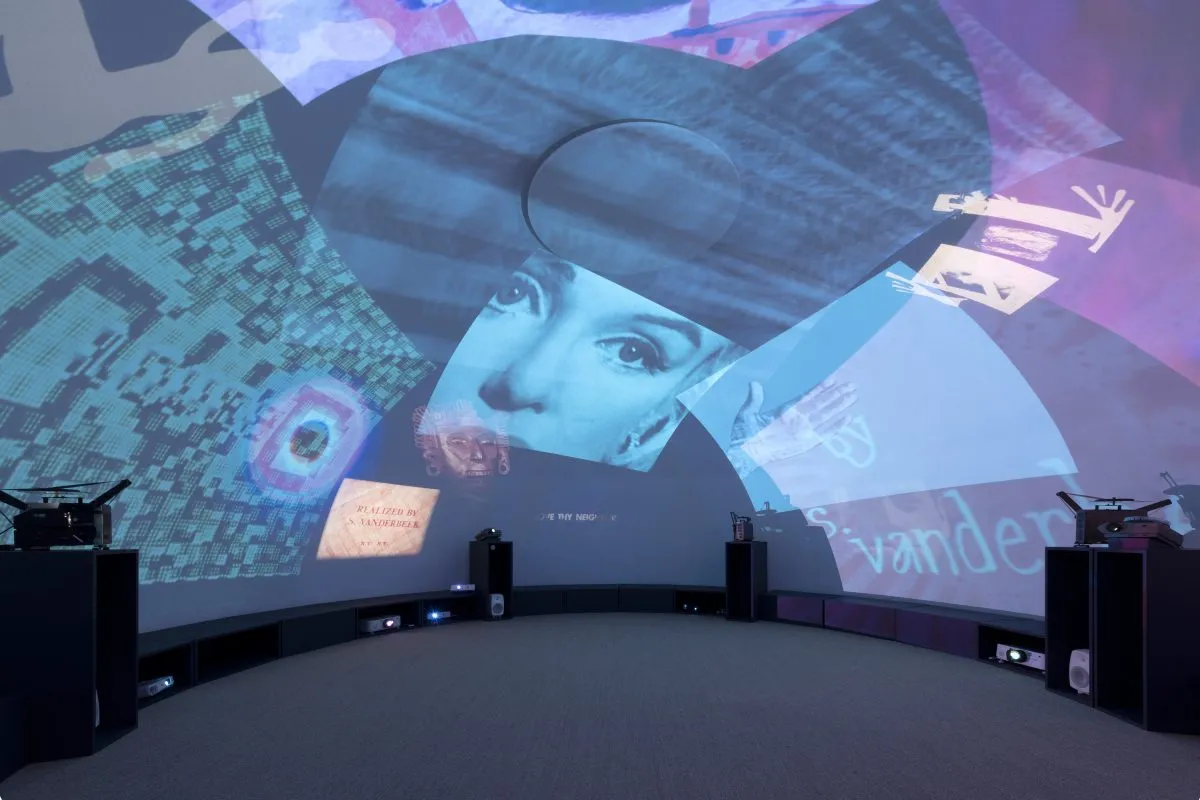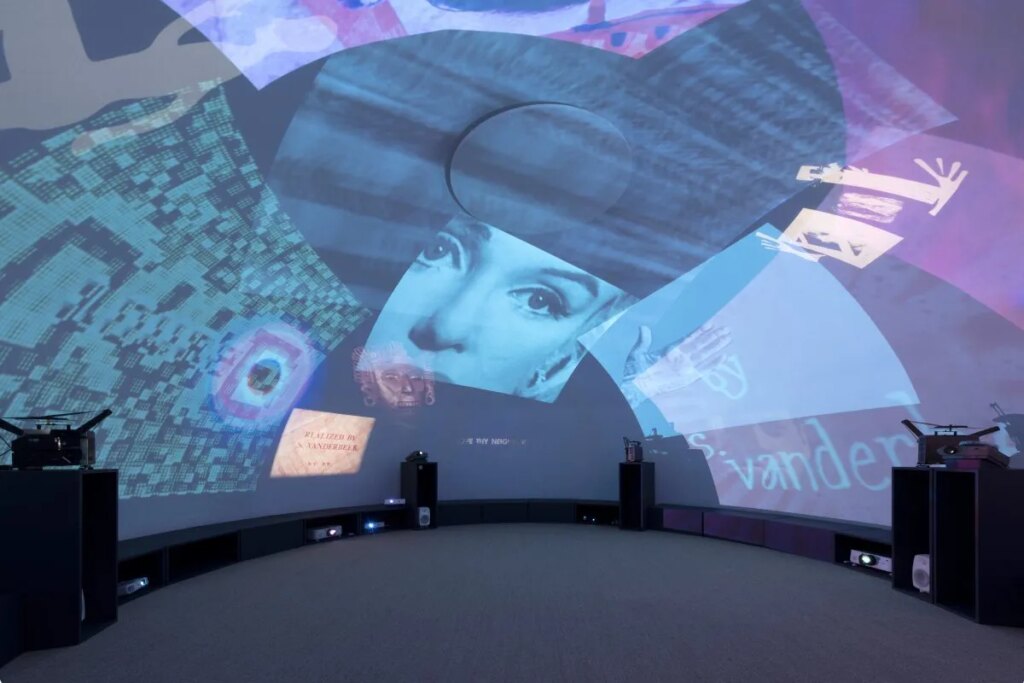
The archive of Stan VanDerBeek, an experimental filmmaker and pioneer of computer-generated art in through the 1950s and 1970s, has joined the roster of Chinatown gallery Magenta Plains.
For years, VanDerBeek’s work has lived outside of the commercial gallery context. In 2008, two of the artists children, Johannes and Sara VanDerBeek, both working artists, took over as managers of the archive from their mother, who had overseeing it since 1984, the year their father died at the age of 57. At the time, the two connected with Chelsea Spengemann, who now serves as the archive’s director. While she was working at the siblings’ New York gallery, Guild & Greyshkul, the three organized an exhibition on VanDerBeek’s practice. “We all began to have the experience and the space to understand the breadth of his work that remained extant,” Sara VanDerBeek told ARTnews.
Almost 40 years after the artist’s death, Magenta Plains will take VanDerBeek’s work to a presentation at Art Basel Miami, which will open next month. The gallery is also planning an exhibition dedicated to VanDerBeek for March.
In an interview with ARTnews, Spengemann and VanDerBeek’s children said that what drew them to Magenta Plains is a cooperative spirit that felt distinct from the gallery’s peers. Olivia Smith, one of the Magenta Plains three directors, pointed out that her cofounders Chris Dorland and David Deutsch, both artists and the latter who was active in New York in the 1970s, are key to that dynamic. Dorland had an existing relationship with Johannes VanDerBeek that helped facilitate plans for representation.
“[Stan VanDerBeek] was very much an artist’s artist and a curator’s artists. To bring his work into this a commercial gallery setting very carefully with the intention for long term care preservation is the key goal,” Spengemann said, adding, “It deserves to have a place in the market, to have a monetary value and to be collected.”
Smith said the move to work with the archive follows an earlier effort in bringing other key players in the history of technologically based art to further focus. In 2016, Smith, alongside Dorland and Deutsch, helped reintroduce the work of Lillian Schwartz, 96, another key figure in computer-mediated art, after her practice had lost exposure.
Since then, with artificial intelligence’s expanding presence in the mainstream, museums have responded by looking at intersections of art and technology. In March, VanDerBeek’s “Movie-Drome,” an installation first built in 1965 where he explores the idea of “visual velocity” through networks of images, took center stage at New York’s Museum of Modern Art’s exhibition, “Signals: How Video Transformed the World.” Sara described the process to reengineer it for the exhibition with the museum’s curatorial staff as “intensive.”
Spengemann echoed how labor intensive the process is to govern and organize the archive of an experimental practice with limited outside resources. Collected over two decades, it spans literature, drawings, collages, photographs and other ephemera relating to the artist’s performances and installations. Certain projects were only sparsely documented. In some cases, Sara and Johannes said they had to rely on the accounts of their older siblings to piece together the parts of their father’s process that hadn’t been recorded while he was alive. Now, four decades later, their goal is to further place the work with important institutions and make visible the lesser-known aspects of the artist’s practice.
“We’re doing a cultural service,” added Spengemann.
Sara emphasized, “It’s very collective. He is the guiding voice. His manifesto, such as Culture, Intercom, his belief in the artists as a civic and engaged human being, and his community-minded approach, also drive our desire to realize, to the best of our ability, the inclusive, immersive, and civically engaged qualities of these media works that he was presenting.”
Exact details on what will be shown in a forthcoming exhibition in March at the gallery have yet to be fully decided, VanderBeek’s children told ARTnews. The pair, alongside Smith and Spengemann, said that they’re aiming to show a grouping of their father’s seminal works that mark milestones from his practice from the mid 1960 and 1970s. One work that they said will be exhibited is the 1970 project Panels for the Walls of the World, a 153-part collage that VanDerBeek compiled using images charting various tensions in the U.S that dominated the news cycle at the time, ranging from racial divisions to militarism. The archive and the gallery are together parsing out how to represent his 1965 manifesto “Culture: Intercom and Expanded Cinema,” in a gallery setting.
While they prepare for that show in New York, Magenta Plains is planning to present in Miami VanDerBeek’s 1967 10-minute-long 16mm film Moirage, made using moire patterns that were produced by the biophysicist Gerald Oster for the stills. At the fair, Smith said the aim is to engage museum curators with the work, and also to demonstrate the ways VanDerBeek acted as an “agitator,” having potentially foreseen trends in media that came long after he died.
Throughout his lifetime, as a professor and collaborator with MIT and Bell Telephone Laboratories, his children noted that he advocated for artists to have access to emerging technologies. They emphasized that he was equally fixated on resisting ways in which civilians could become passive in the face of political transgressions that might otherwise feel distant.
The work that his children say they still have left to do with their father’s archive is to make it seen how far ahead he was thinking into the future. In a 1970 essay in Art in America, VanderBeek questioned where the escalating role of the computer would eventually lead: “Compare the computer to driving a fast sports car; it is difficult to control,” he wrote, imagining that alongside it would be what he dubbed a “technician-artist-citizen.”
Smith said that beyond finalizing current conversations with curators at U.S. institutions on potential placements of the work, there is another long-term aim with the archive. Smith hopes to carve out an audience among other still-maturing artists whose practices are based in media.
“We think our work together with the archive, and in our future presentations will impact younger generations of artists to actually ask themselves what their role is,” said Smith.


